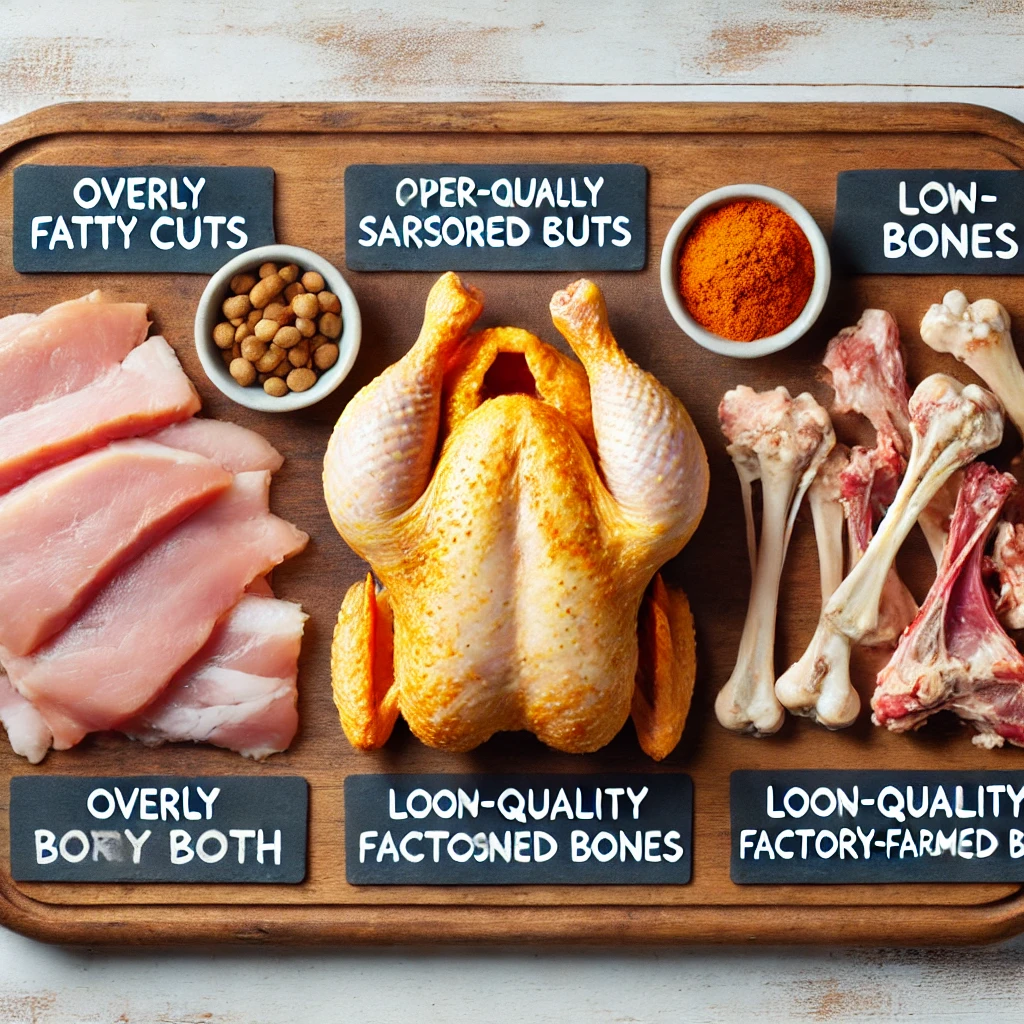Outline
Introduction
- The importance of choosing the right bones for chicken bone broth.
- How bone selection impacts flavor, texture, and nutrition.
Types of Bones to Use for Chicken Bone Broth
Carcass Bones
- Why chicken carcasses are ideal.
- Joint Bones
- Chicken feet, wings, and necks: high collagen content.
- Meaty Bones
- Chicken drumsticks and thighs for added richness.
Why Certain Bones Are Better for Bone Broth
- High Collagen Content for Gelatinous Broth
- Benefits of collagen-rich bones.
- Flavor Contribution
- The role of meaty bones in enhancing taste.
- Nutritional Benefits
- Key nutrients released from different bones.
Bones to Avoid in Chicken Bone Broth
- Overly fatty cuts.
- Processed or pre-seasoned bones.
- Low-quality or factory-farmed bones.
Tips for Selecting the Best Bones
- Opt for organic, free-range chicken.
- Balance meaty and bony parts.
- Roast the bones for deeper flavor.
FAQs
- Can I use leftover bones for chicken bone broth?
- Are raw or cooked bones better for broth?
- How many bones do I need for a good batch of broth?
Conclusion
- Highlight the benefits of choosing the best bones.
- Encourage experimentation with different bone combinations.
What Bones Are Best for Chicken Bone Broth?
Introduction
Chicken bone broth is a staple in kitchens worldwide, known for its rich flavor, versatility, and numerous health benefits. Whether you’re using it as a base for soups, sauces, or sipping it on its own, the quality of your broth depends heavily on the type of bones you use.
Choosing the right bones not only enhances the flavor but also impacts the texture and nutritional profile of your broth. Some bones provide more collagen for a gelatinous consistency, while others add depth and richness to the taste. This guide will help you understand which chicken bones work best for bone broth and why they’re ideal.
Types of Bones to Use for Chicken Bone Broth

The foundation of a great chicken bone broth lies in the selection of bones. Each type of bone contributes unique qualities, from flavor to texture, making the combination of bones an essential factor in crafting the perfect broth.
Carcass Bones
The chicken carcass—what remains after the meat has been removed—is a prime choice for bone broth.
- Why It’s Ideal:
- The carcass contains a mix of bone, cartilage, and residual meat, offering a balanced combination of flavor and nutrients.
- It’s an economical option, especially if you save leftover roasted or raw chicken carcasses.
- Best Use:
- Combine with other bones, like wings or feet, to add collagen and depth.
Joint Bones
Bones with connective tissue, such as chicken feet, wings, and necks, are collagen powerhouses.
- Chicken Feet:
- Contain high levels of collagen, which creates a gelatinous, nutrient-rich broth.
- Add a velvety texture and boost the broth’s nutritional value.
- Chicken Wings:
- Include small bones, cartilage, and skin, all contributing to a flavorful and collagen-rich broth.
- Chicken Necks:
- Compact and packed with connective tissue, ideal for building body and richness in the broth.
Meaty Bones
Including meaty bones like drumsticks or thighs in your broth adds extra richness and depth of flavor.
- Why Include Them:
- The meat left on the bones enhances the broth’s taste.
- Adds a savory, umami element that balances the lightness of other bones.
- Pro Tip: Roast meaty bones before simmering to caramelize the meat and improve the broth’s flavor.
Why Certain Bones Are Better for Bone Broth
Not all chicken bones are created equal when it comes to making bone broth. The best bones contribute to the broth’s texture, flavor, and nutrient density, making it both delicious and healthy. Here’s why specific bones stand out:
High Collagen Content for Gelatinous Broth
- What Collagen Does:
- Collagen is a protein found in connective tissues, and when simmered, it breaks down into gelatin. This gelatin gives the broth its signature thick and silky texture.
- Best Sources:
- Chicken feet, necks, and wings are packed with collagen.
- Why It Matters:
- Gelatin-rich broth supports joint health, improves digestion, and is great for skin and hair.
Flavor Contribution
- The Role of Meaty Bones:
- Bones with residual meat, like drumsticks or thighs, release savory juices and fats, creating a richer broth.
- Balancing the Blend:
- Combining meaty bones with neutral carcass bones creates a well-rounded flavor profile.
Nutritional Benefits
- What Bones Add to Broth:
- Bones are a rich source of minerals like calcium, magnesium, and phosphorus. These minerals leach into the broth during simmering, boosting its nutritional value.
- Marrow Benefits:
- Bones with marrow, such as from the thighs or drumsticks, provide additional nutrients like healthy fats and vitamins.
Using the right combination of collagen-rich and meaty bones ensures a flavorful, nutritious, and well-balanced chicken bone broth.
Bones to Avoid in Chicken Bone Broth
While most chicken bones work well for making broth, certain types can negatively impact the flavor, texture, and overall quality. Knowing which bones to avoid is just as important as choosing the right ones.

1. Overly Fatty Cuts
- Why Avoid?
- Bones with excessive fat, such as skin-on thighs or drumsticks, can make the broth overly greasy.
- Excess fat can also mask the natural flavors of the broth and make it feel heavy.
- How to Fix It:
- Trim visible fat before adding bones to the pot.
- Skim fat from the surface while simmering to prevent greasiness.
2. Processed or Pre-Seasoned Bones
- Why Avoid?
- Pre-seasoned or processed bones, such as rotisserie chicken leftovers, often contain added salt, spices, and preservatives. These additives can overpower the broth or introduce artificial flavors.
- Some seasonings, like garlic powder or paprika, may turn bitter during long cooking times.
- Better Option:
- Use plain, unseasoned bones to ensure full control over the broth’s flavor.
3. Low-Quality or Factory-Farmed Bones
- Why Avoid?
- Bones from conventionally raised chickens may have lower nutrient content compared to bones from organic or free-range chickens.
- Factory-farmed bones may also contain residual antibiotics or hormones.
- Better Option:
- Choose high-quality bones from pasture-raised or organic chickens for a cleaner, more nutritious broth.
Avoiding these types of bones helps ensure your chicken bone broth is flavorful, nutrient-rich, and free of unwanted additives.
Tips for Selecting the Best Bones
Choosing the right bones is the foundation of a flavorful and nutritious chicken bone broth. Here are some tips to ensure you’re using the best bones for optimal results.
1. Opt for Organic, Free-Range Chicken
- Why It Matters:
- Organic, free-range chickens are raised without antibiotics or hormones, making their bones a healthier and cleaner option for broth.
- These chickens often have more nutrient-dense bones, enhancing the broth’s overall quality.
- Pro Tip: Look for local sources or trusted suppliers to ensure the highest quality.
2. Balance Meaty and Bony Parts
- Why It Matters:
- A mix of bones ensures your broth has a well-rounded flavor and texture.
- Meaty bones like drumsticks add richness, while collagen-rich bones like feet or necks create a gelatinous texture.
- Pro Tip: Use a ratio of approximately 70% bony parts (carcasses, necks, feet) to 30% meaty parts (thighs, wings).
3. Roast the Bones for Deeper Flavor
- Why It Matters:
- Roasting caramelizes the bones, unlocking rich, smoky flavors that enhance the broth.
- The roasted bits add depth to the broth, making it more robust and savory.
- How to Do It:
- Preheat your oven to 400°F (200°C). Arrange the bones in a single layer on a baking sheet and roast for 30-40 minutes until golden brown.
4. Use Marrow-Rich Bones
- Why It Matters:
- Bones with marrow, like drumsticks or thighs, release healthy fats and nutrients that boost the broth’s richness.
- Pro Tip: Combine marrow-rich bones with lighter options like carcasses or wings for a balanced flavor profile.
5. Avoid Overcrowding the Pot
- Why It Matters:
- Overloading the pot with too many bones can result in a muddy, over-extracted broth.
- Proper space allows water to circulate, ensuring even extraction of flavors and nutrients.
- Pro Tip: Use about 1-2 pounds of bones per gallon of water for the ideal balance.
.
FAQs About Chicken Bone Broth Bones
Here are answers to some frequently asked questions about selecting the best bones for chicken bone broth.
1. Can I Use Leftover Bones for Chicken Bone Broth?
- Answer: Absolutely! Leftover bones from roasted or baked chicken are perfect for broth.
- Pro Tip: Combine leftover bones with fresh ones like chicken feet or necks to boost collagen and flavor.
2. Are Raw or Cooked Bones Better for Broth?
- Answer: Both work, but they serve different purposes:
- Raw Bones: Ideal for extracting maximum nutrients and collagen.
- Cooked Bones: Add roasted flavors but may have slightly reduced nutrient content.
- Best Option: Roast raw bones before using for a balance of flavor and nutrition.
3. How Many Bones Do I Need for a Good Batch of Broth?
- Answer: Use about 1-2 pounds of bones per gallon of water. This ratio creates a rich, flavorful broth without overcrowding the pot.
- Pro Tip: Adjust the water level as the broth simmers to maintain the ideal consistency.
Conclusion
Choosing the right bones for chicken bone broth is essential for crafting a flavorful, nutritious, and versatile broth. By selecting high-collagen options like chicken feet and necks, incorporating meaty bones for richness, and avoiding overly fatty or processed parts, you can elevate your broth-making process.
Key Takeaways
- Balance Is Key: A mix of bony and meaty parts ensures depth of flavor and the perfect texture.
- Quality Matters: Opt for organic, free-range bones to maximize nutrients and avoid harmful additives.
- Enhance Flavor: Roast your bones and use proper ratios to achieve a rich, clear broth.
With the right bones and techniques, your chicken bone broth will become a nourishing staple in your kitchen, perfect for soups, sauces, or enjoying on its own. Experiment with combinations and savor the benefits of this time-honored culinary tradition!

